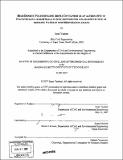| dc.contributor.advisor | Susan Murcott. | en_US |
| dc.contributor.author | Yazdani, Iman | en_US |
| dc.contributor.other | Massachusetts Institute of Technology. Dept. of Civil and Environmental Engineering. | en_US |
| dc.date.accessioned | 2007-10-22T17:29:18Z | |
| dc.date.available | 2007-10-22T17:29:18Z | |
| dc.date.copyright | 2007 | en_US |
| dc.date.issued | 2007 | en_US |
| dc.identifier.uri | http://hdl.handle.net/1721.1/39273 | |
| dc.description | Thesis (M. Eng.)--Massachusetts Institute of Technology, Dept. of Civil and Environmental Engineering, 2007. | en_US |
| dc.description | Includes bibliographical references (leaves 76-82). | en_US |
| dc.description.abstract | The purpose of this study is to investigate the technical feasibility of high density polyethylene (HDPE) containers as an alternative to polyethylene terephthalate (PET) bottles for the solar disinfection of drinking water in the Northern Region of Ghana, in a process know as SOLAIR. This study is in line with the intention of Pure Home Water, a registered non-profit organization in Ghana, to offer a variety of low-cost household water treatment and safe storage (HWTS) products as it continues to grow, including the possibility of offering a solar disinfection product in the future. If successful, SOLAIR is practically advantageous over SODIS, which uses smaller PET bottles, chiefly due to the ability to use a larger water container (2-25L), and one that is more likely to be available in a rural setting, given the widespread use of HDPE jerry cans as water collection and storage vessels in many developing countries. The main idea behind the SOLAIR system is to keep high dissolved oxygen (DO) levels in the water which, in turn, enhances disinfection. A study done by Meyer et al. (2000), in South Africa, showed that regular shaking of the water-filled HDPE container keeps DO at sufficiently high levels to augment disinfection. | en_US |
| dc.description.abstract | (cont.) The SOLAIR results, using 10L translucent HDPE containers, obtained in Tamale, Ghana over the month of January, 2007, show that complete solar disinfection of water over the course of 7 consecutive hours of solar exposure, did not take place. It is believed that the primary reason for the low degree of disinfection is the scattering and absorption of UV radiation by the aerosol particles present in the seasonal Harmattan (Sahara dust) haze, which thereby reduces the amount of UV light that reaches the earth's surface. Using radiation measurements, obtained in Tamale, a model relating the solar radiation intensity versus NASA's OMI Aerosol Index (AI), which is a measure of the amount of particulates in the atmosphere, was derived. Another key conclusion suggested by this study is that shaking does not increase the DO concentration in the SOLAIR water to sufficient levels, if at all, to augment photo-oxidative disinfection, due to the fact that the oxygen level of the sample water was already near saturation. Laboratory tests performed substantiate this claim. In brief, this solar disinfection process, using translucent 10L HDPE containers, in January in Northern Region, Ghana, does not produce a safe drinking water. | en_US |
| dc.description.statementofresponsibility | by Iman Yazdani. | en_US |
| dc.format.extent | 115 leaves | en_US |
| dc.language.iso | eng | en_US |
| dc.publisher | Massachusetts Institute of Technology | en_US |
| dc.rights | M.I.T. theses are protected by copyright. They may be viewed from this source for any purpose, but reproduction or distribution in any format is prohibited without written permission. See provided URL for inquiries about permission. | en_US |
| dc.rights.uri | http://dspace.mit.edu/handle/1721.1/7582 | |
| dc.subject | Civil and Environmental Engineering. | en_US |
| dc.title | High density polyethylene (HDPE) containers as an alternative to polyethylene terephthalate (PET) bottles for solar disinfection of drinking water in northern region, Ghana | en_US |
| dc.title.alternative | HDPE containers as an alternative to polyethylene terephthalate (PET) bottles for solar disinfection of drinking water in northern region, Ghana | en_US |
| dc.type | Thesis | en_US |
| dc.description.degree | M.Eng. | en_US |
| dc.contributor.department | Massachusetts Institute of Technology. Department of Civil and Environmental Engineering | |
| dc.identifier.oclc | 170932837 | en_US |
